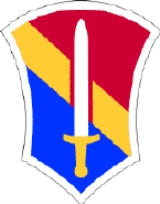
I Field Force, Vietnam
Encyclopedia
I Field Force, Vietnam was a Corps
-level command of the United States Army
during the Vietnam War
.
Activated on 15 March 1966, it was the successor to Field Force
Vietnam, a provisional corps command created 15 November 1965 for temporary control of activities of U.S. Army ground combat units arriving in Vietnam. I Field Force was a component of U.S. Military Assistance Command Vietnam
(MACV) and had its headquarters at Nha Trang
.
I Field Force's area of responsibility was II Corps Tactical Zone, later renamed Military Region 2, which comprised the twelve provinces of Vietnam's Central Highlands. Among the divisions and brigades it controlled were:
I Field Force was deactivated on 30 April 1971 during the withdrawal of U.S. ground combat forces from Vietnam, and its assets formed the basis for its successor, the Second Regional Assistance Command (SRAC).
Corps
A corps is either a large formation, or an administrative grouping of troops within an armed force with a common function such as Artillery or Signals representing an arm of service...
-level command of the United States Army
United States Army
The United States Army is the main branch of the United States Armed Forces responsible for land-based military operations. It is the largest and oldest established branch of the U.S. military, and is one of seven U.S. uniformed services...
during the Vietnam War
Vietnam War
The Vietnam War was a Cold War-era military conflict that occurred in Vietnam, Laos, and Cambodia from 1 November 1955 to the fall of Saigon on 30 April 1975. This war followed the First Indochina War and was fought between North Vietnam, supported by its communist allies, and the government of...
.
Activated on 15 March 1966, it was the successor to Field Force
Field Force
A Field Force in British and Indian Army military parlance is a combined arms land force operating under actual or assumed combat circumstances usually for the length of a specific military campaign....
Vietnam, a provisional corps command created 15 November 1965 for temporary control of activities of U.S. Army ground combat units arriving in Vietnam. I Field Force was a component of U.S. Military Assistance Command Vietnam
Military Assistance Command, Vietnam
The U.S. Military Assistance Command, Vietnam, MACV, , was the United States' unified command structure for all of its military forces in South Vietnam during the Vietnam War.-History:...
(MACV) and had its headquarters at Nha Trang
Nha Trang
Nha Trang is a coastal city and capital of Khanh Hoa province, on the South Central Coast of Vietnam. It is bounded on the North by Ninh Hoà district, on the East by the South China Sea, on the South by Cam Ranh town and on the West by Diên Khánh district...
.
I Field Force's area of responsibility was II Corps Tactical Zone, later renamed Military Region 2, which comprised the twelve provinces of Vietnam's Central Highlands. Among the divisions and brigades it controlled were:
- 1st Cavalry Division (Airmobile)
- 4th Infantry Division
- 3d Brigade, 25th Infantry Division
- 1st Brigade, 101st Airborne Division101st Airborne Division (United States)The 101st Airborne Division—the "Screaming Eagles"—is a U.S. Army modular light infantry division trained for air assault operations. During World War II, it was renowned for its role in Operation Overlord, the D-Day landings on 6 June 1944, in Normandy, France, Operation Market Garden, the...
- 173rd Airborne Brigade
I Field Force was deactivated on 30 April 1971 during the withdrawal of U.S. ground combat forces from Vietnam, and its assets formed the basis for its successor, the Second Regional Assistance Command (SRAC).
Commanders
- LTG Stanley R. Larsen March 1966 – July 1967
- LTG William B. RossonWilliam B. RossonGeneral William Bradford Rosson commanded the U.S. Army, Pacific from October 1970 to January 1973. He was commissioned in 1940 through ROTC and saw combat in World War II, earning the Distinguished Service Cross for valor on the Anzio Beachhead in Italy...
July 1967– February 1968 - LTG William R. PeersWilliam R. PeersWilliam R. Peers was a United States Army General, who is most notable for presiding over the Peers Commission investigation into the My Lai massacre and other similar war crimes during the Vietnam War.-Biography:...
March 1968 – March 1969 - LTG Charles A. Corcoran March 1969 – March 1970
- LTG Arthur S. Collins, Jr. March 1970 – January 1971
- MG Charles P. Brown January 1971 – April 1971

